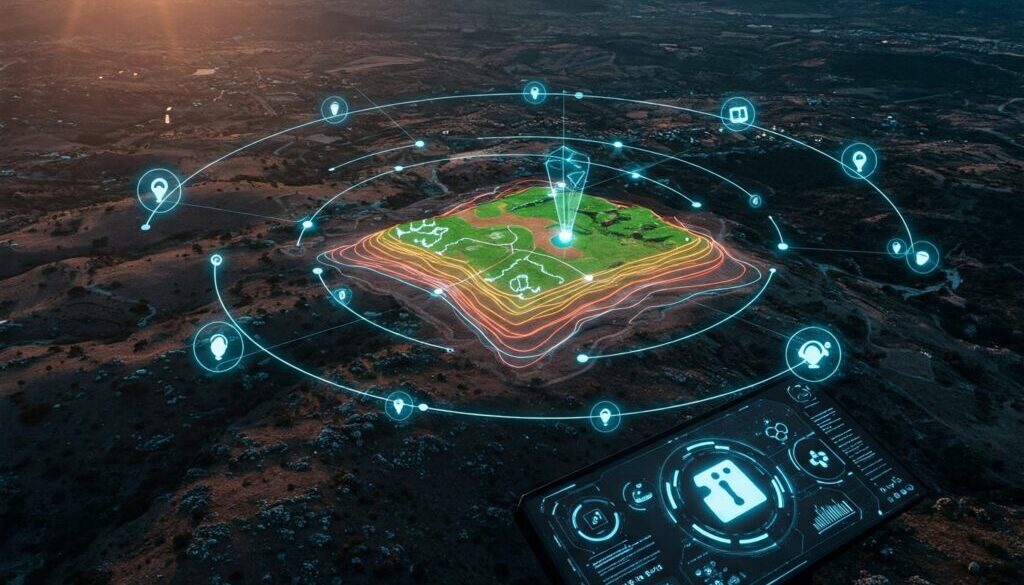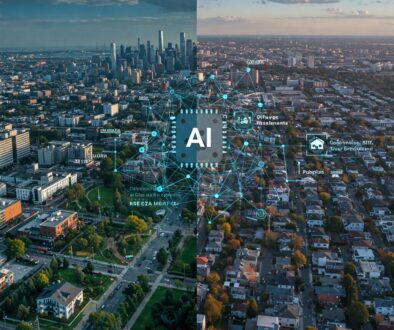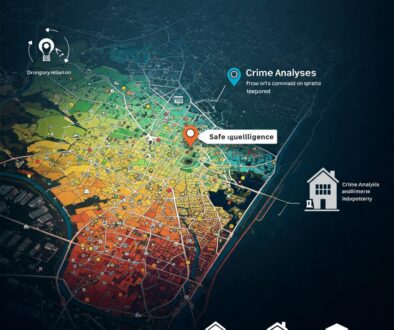AI-Powered Due Diligence: The New Standard for Land Acquisition
The due diligence process for land acquisition has traditionally been fragmented, time-consuming, and often incomplete. Investors and developers typically cobble together information from multiple sources, rely heavily on third-party reports of varying quality, and still face significant unknown factors when making multi-million dollar decisions.
In 2025, AI-powered geospatial intelligence platforms like Locas.dev are establishing a new standard for land acquisition due diligence—one that is more comprehensive, faster, and increasingly essential in a competitive market where information advantages translate directly to investment performance.
The Evolution of Land Acquisition Due Diligence
Traditional Approach
The conventional due diligence process typically involves:
- Physical site inspection with visual assessment
- Survey and boundary verification
- Title search and report review
- Environmental Phase I assessment
- Zoning and entitlement confirmation
- Geotechnical studies for soil conditions
- Infrastructure availability verification
- Market analysis for highest and best use
This approach, while still valuable, has significant limitations:
- Time-consuming process often taking 30-90 days
- Siloed information without integrated analysis
- Limited historical context for environmental factors
- Minimal future projection for changing conditions
- High dependency on third-party expertise quality
- Significant gaps between different assessment aspects
The AI-Enhanced Approach
Modern geospatial intelligence platforms transform this process through:
- Multi-source data integration across dozens of datasets
- Historical pattern analysis spanning decades
- Predictive modeling for future conditions and risks
- Comprehensive visualization of integrated findings
- Systematic gap identification highlighting unknowns
- Comparative benchmark analysis against similar properties
“What used to take weeks of coordinating different consultants can now be accomplished in hours,” explains Michael Chen, acquisition director at Horizon Development. “More importantly, we’re getting insights that would have been nearly impossible to uncover through traditional methods alone.”
Seven Ways AI is Transforming Land Acquisition Due Diligence
1. Environmental Risk Assessment Beyond Phase I
Traditional Approach: Standard Phase I environmental assessments rely primarily on historical records, databases of known contamination, and visual inspection, often missing subtle indicators of potential issues.
AI-Enhanced Approach: Advanced platforms deliver more comprehensive environmental intelligence:
- Historical aerial imagery analysis identifying potential undocumented usage
- Soil composition prediction modeling based on regional patterns
- Contamination probability assessment derived from historical industrial patterns
- Groundwater flow analysis for migration risk from nearby sites
- Multi-factor environmental risk scoring across numerous categories
Real-World Impact: “We were evaluating a seemingly clean site that had passed a standard Phase I assessment,” notes Rebecca Sanchez of Meridian Investments. “The AI analysis identified subtle vegetation patterns in historical imagery that suggested unnatural soil conditions in one corner of the property. Targeted testing revealed an undocumented underground storage tank that would have cost hundreds of thousands to remediate had we discovered it after purchase.”
2. Future-Focused Infrastructure Analysis
Traditional Approach: Basic verification of current utility connections and capacity, often with limited investigation of infrastructure age, condition, or future adequacy.
AI-Enhanced Approach: Comprehensive infrastructure intelligence includes:
- Infrastructure age and condition assessment
- Capacity adequacy modeling for future development
- Capital improvement plan analysis for regional upgrades
- Infrastructure vulnerability assessment for climate impacts
- Cost-sharing risk evaluation for future improvements
Real-World Impact: A residential developer was considering a 120-acre parcel with apparently suitable water and sewer capacity. AI-powered infrastructure analysis revealed that the sewer system serving the area was at 92% of capacity, and the municipality had a history of requiring developers to fund significant portions of infrastructure upgrades once capacity thresholds were crossed. This intelligence allowed them to negotiate infrastructure contribution limits into their purchase agreement, protecting against a potential $3.7 million unexpected cost.
3. Contextual Zoning and Entitlement Intelligence
Traditional Approach: Basic confirmation of current zoning and entitlements, with limited insight into potential changes or approval likelihood for requested modifications.
AI-Enhanced Approach: More sophisticated zoning and entitlement analysis provides:
- Regulatory pattern recognition across similar jurisdictions
- Approval probability modeling based on historical decisions
- Policy evolution prediction for future zoning changes
- Development standard trend analysis identifying regulatory direction
- Community sentiment assessment for development support
Real-World Impact: “The property we were evaluating needed a height variance to achieve our development program,” explains James Thompson of Urban Development Partners. “Traditional analysis simply noted this requirement, but the AI platform analyzed five years of variance decisions in the jurisdiction and identified specific design modifications that had increased approval probability by over 80% in similar cases. This intelligence fundamentally changed our approach to the project and ultimately led to approval.”
4. Dynamic Market Opportunity Assessment
Traditional Approach: Point-in-time market analysis based on current conditions and comparable properties, often lacking forward-looking insights or hyperlocal variations.
AI-Enhanced Approach: Comprehensive market intelligence includes:
- Hyperlocal demand pattern analysis at neighborhood scale
- Development pipeline impact assessment on future supply
- Price elasticity modeling for different product types
- Absorption rate prediction based on multiple factors
- Demographic evolution forecasting for changing demand
Real-World Impact: A mixed-use developer was evaluating land in an area traditionally dominated by single-family homes. While conventional market analysis showed limited multifamily precedent, AI-powered demographic and migration pattern analysis identified a growing mismatch between household formation patterns and available housing types. The developer created a residential product specifically targeting this emerging demand gap, achieving 22% higher returns than projected by traditional market assessment.
5. Comprehensive Physical Constraints Mapping
Traditional Approach: Basic topographical review and identification of obvious physical limitations, often missing subtle constraints that can significantly impact development potential.
AI-Enhanced Approach: Advanced physical analysis includes:
- Micro-topographical opportunity mapping
- Viewshed and visual corridor analysis
- Natural drainage pattern identification
- Solar exposure optimization potential
- Acoustic environment assessment
Real-World Impact: When evaluating two seemingly similar parcels, Capital Partners discovered through AI analysis that one property had significantly better natural drainage patterns that would reduce stormwater management costs by approximately $850,000. Additionally, the analysis identified a natural landform that could be leveraged to create premium viewshed lots, increasing projected revenue by 7% – factors that weren’t apparent in conventional due diligence.
6. Historical Pattern Recognition
Traditional Approach: Limited historical research focused primarily on ownership and known issues, missing broader patterns that might affect property value or development potential.
AI-Enhanced Approach: Sophisticated historical analysis includes:
- Multi-decade land use evolution tracking
- Development pattern recognition across the region
- Historical imagery analysis for undocumented features
- Community development trajectory mapping
- Long-term environmental condition assessment
Real-World Impact (continued): “The AI platform identified a pattern in historical aerial imagery that wasn’t obvious in current conditions,” explains Robert Chen of Summit Acquisitions. “Subtle vegetation and drainage patterns indicated that a portion of the site had been periodically saturated, despite not being in any flood zone. This insight led us to modify our site plan to place only recreational uses in that area, avoiding potential structural issues that would have emerged years later. Without historical pattern recognition, we would have built homes in an area with hidden hydrological challenges.”
7. Integrated Comparative Analysis
Traditional Approach: Limited comparison to a small set of local comparable properties, often based primarily on price per acre or basic zoning characteristics.
AI-Enhanced Approach: Comprehensive comparative intelligence includes:
- Multi-factor property matching across numerous characteristics
- Performance pattern identification from similar sites
- Development outcome comparison from matched properties
- Risk profile benchmarking against comparable projects
- Optimization opportunity identification based on similar site outcomes
Real-World Impact: A developer evaluating land for a mixed-use project utilized AI-powered comparative analysis to identify similar developments across multiple markets. The analysis revealed specific site plan configurations and unit mixes that had consistently outperformed others across comparable locations. By incorporating these insights into their development approach, they achieved an 18% higher return compared to their original concept—intelligence that wouldn’t have emerged from traditional local comparable analysis.
Case Study: The Westridge Acquisition
When Centennial Partners was considering a 75-acre land acquisition for a master-planned community, they employed both traditional due diligence and AI-powered geospatial intelligence to assess the opportunity. The difference in findings was striking:
Traditional Due Diligence Results:
- Clean Phase I environmental assessment
- Suitable zoning for intended use
- Adequate existing infrastructure reported
- Favorable market conditions noted
- Feasible topography for development
- No apparent title issues
- Acceptable soil conditions in limited testing
AI-Enhanced Due Diligence Findings:
- 22% of the site showed historical indicators suggesting seasonal high water table
- Infrastructure capacity projected to reach limits requiring $2.1M in upgrades
- Development approval patterns revealed specific design elements that significantly improved entitlement success
- Micro-market analysis identified opportunity for 15% premium for south-facing lots
- Comparative analysis showed 34% higher returns for projects incorporating specific amenity configurations
- Historical imagery revealed undocumented agricultural drainage structures
- Demographic trajectory analysis supported higher-density products than initially planned
Based on this comprehensive intelligence, Centennial:
- Redesigned their site plan to optimize for the newly discovered constraints and opportunities
- Negotiated specific infrastructure contribution limits in their purchase agreement
- Adjusted their product mix to align with identified demographic trends
- Incorporated the specific design elements that improved approval probability
- Modified their amenity package based on comparative performance data
The result was a project that achieved 27% higher returns than originally projected, despite a slightly higher land acquisition cost than competitors who relied on traditional due diligence alone.
Implementing AI-Powered Due Diligence in Your Acquisition Strategy
To leverage these advanced capabilities in your land acquisition process:
1. Integrate AI Analysis Early in the Process
Rather than using AI as a final verification tool, incorporate it in your initial site selection and evaluation to identify optimal opportunities and eliminate problematic sites before investing significant time and resources.
2. Create a Systematic Evaluation Framework
Develop a structured approach to AI-powered due diligence that covers:
- Environmental risk assessment
- Infrastructure evaluation
- Regulatory analysis
- Market opportunity mapping
- Physical constraints identification
- Historical pattern recognition
- Comparative benchmarking
3. Use AI Findings to Guide Traditional Due Diligence
Let AI intelligence direct your conventional investigation efforts:
- Target environmental testing in areas with identified risk indicators
- Focus infrastructure capacity questions on specific concerns
- Direct legal review toward regulatory risks flagged by pattern analysis
- Guide market studies based on opportunity gaps identified
- Concentrate physical analysis on areas with potential constraints
4. Incorporate Intelligence into Acquisition Terms
Leverage AI findings to structure more advantageous purchase agreements:
- Data-backed contingency provisions
- Risk-adjusted pricing negotiations
- Specific representation and warranty requirements
- Tiered earnest money release structures
- Performance-based seller financing terms
5. Build Intelligence-Driven Acquisition Teams
Develop teams that can effectively utilize advanced intelligence:
- Train acquisition specialists in AI platform utilization
- Pair technology experts with experienced land professionals
- Create collaborative workflows between AI analysts and domain experts
- Establish intelligence-sharing protocols across the organization
- Continuously refine approaches based on outcome tracking
The Future of AI in Land Acquisition Due Diligence
As technology continues to advance, several emerging capabilities promise to further transform land acquisition:
Automated Opportunity Identification
Future systems will actively identify optimal acquisition targets based on your specific criteria and strategy, continuously scanning the market for properties with ideal characteristic combinations.
Real-time Risk Monitoring
Once properties are under consideration, continuous monitoring will flag emerging issues throughout the due diligence period, such as newly filed permits nearby, regulatory proposals, or environmental incidents.
Development Optimization Simulation
Advanced systems will simulate multiple development approaches for a specific site, identifying the optimal configuration, product mix, and phasing to maximize returns while minimizing risks.
Negotiation Intelligence Support
AI will provide real-time guidance during acquisition negotiations, suggesting specific terms, contingencies, and price adjustments based on comprehensive risk-reward analysis.
Integrated Due Diligence Automation
Future platforms will automatically commission, receive, and analyze traditional due diligence components like title reports, surveys, and environmental assessments, flagging discrepancies with AI-generated insights.
Conclusion: Competitive Advantage Through Superior Intelligence
In today’s increasingly competitive land acquisition market, the information advantage provided by AI-powered due diligence represents a significant edge:
- Identifying hidden risks that others miss, avoiding costly surprises
- Discovering untapped value that traditional analysis overlooks
- Negotiating more favorable terms based on comprehensive intelligence
- Making faster decisions with greater confidence
- Optimizing development approach from the earliest stages
As these technologies continue to mature and become more widespread, the question for land investors is shifting from whether to adopt AI-powered due diligence to how quickly and effectively they can implement it to maintain competitive advantage.
Ready to transform your land acquisition due diligence process? Try Locas.dev today and experience the power of AI-driven geospatial intelligence for your next land investment.
This article reflects the current state of AI technology in land acquisition due diligence. For the latest updates and features, visit Locas.dev.
Keywords: land acquisition due diligence, AI property assessment, real estate due diligence technology, property risk analysis, land development intelligence, geospatial due diligence, AI site selection



